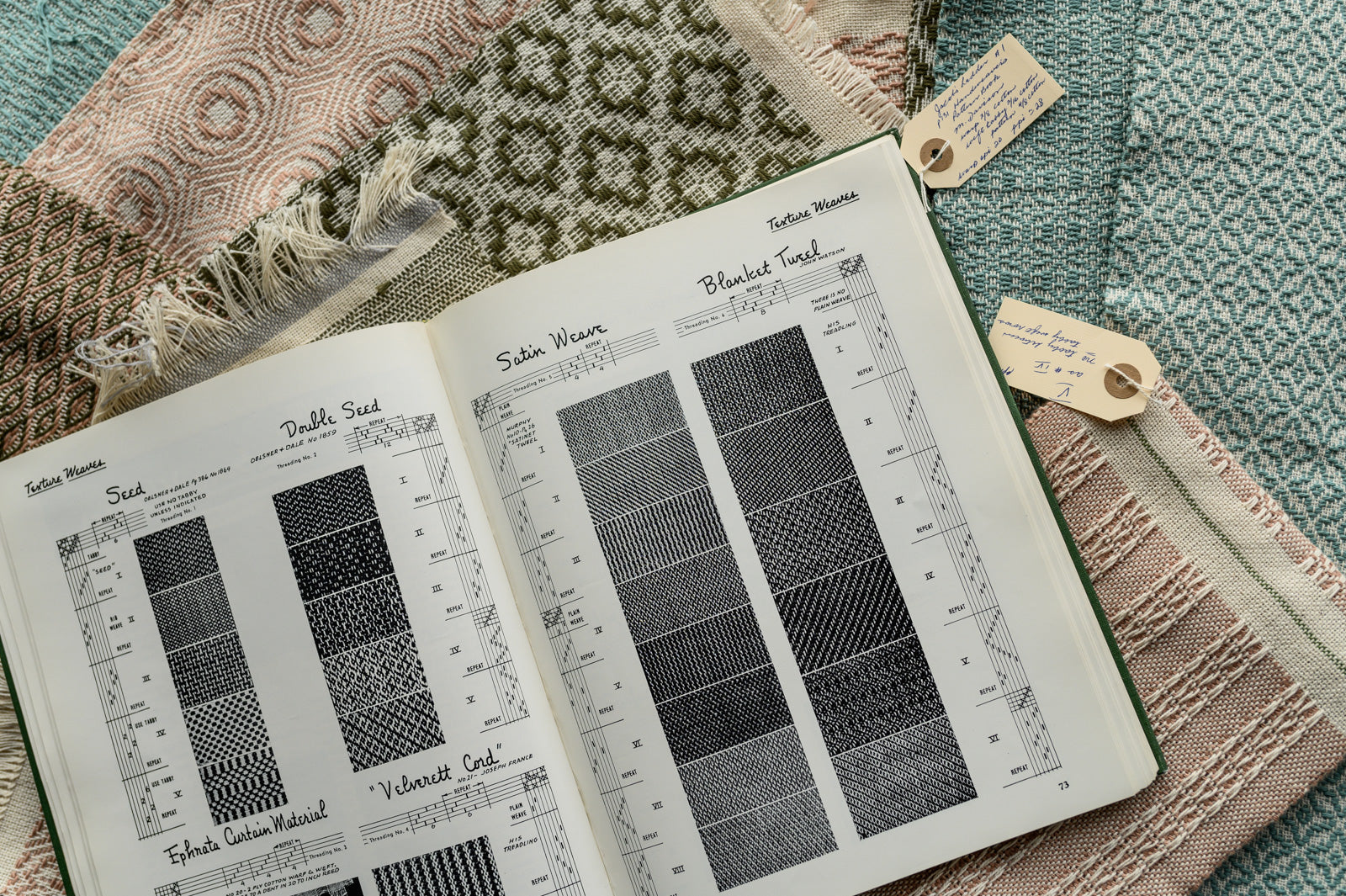When we start weaving, we also start collecting: yarn, reeds, odds and ends, shuttles, bobbins, and of course books. My current weaving library is probably closing in on 100 books these days. But back when I got my first 4-shaft loom, my bookshelves were relatively bare. I had a couple of rigid heddle books and one 4-shaft book my husband had got me by accident. I was watching Jane Stafford’s videos and starting to connect with Gather Textiles, who had only just opened. I really do prefer to learn from books, though, so I had my radar up for useful ones that might be helpful for a beginning 4-shaft weaver.
My secondhand loom came with a box of books, but many were too dense and difficult for an enthusiastic newbie like me to make use of right away. I picked up a new copy of Anne Dixon’s The Handweaver’s Pattern Directory and immediately knew I had found a good tool. My first warp was a sampler where I wove through every single straight draw draft from Dixon. I wanted more books like this: packed with ideas, giving me the structural information that I needed to go off an experiment with. As I dug through the weaving rabbit hole, I started making a running list of other books that might be helpful. Pretty soon, Davison’s A Handweaver’s Pattern Book made it to the top of the list.
My first copy was not the revised version of Davison’s classic, known as “The Green Book”, but a paperback reprint of the first edition known as “The Orange Book”. I snagged a copy, liked how extensive it seemed, and kept happily weaving away. Within a few months I was at a sale put on by a local craft guild and saw a hardcover copy, green dust jacket and all. I knew it was sought after, so for $25 I picked it up.
The green version was a bit easier to read than the orange version. It was still hand-drawn drafts that I had to squint a bit to understand, but it was certainly clear enough to use. Like my paperback copy, it had black and white photographs that made it hard to tell what the finished cloth was actually supposed to look like. That didn’t stop me from falling head over heels in love. I wove pretty much exclusively from A Handweaver’s Pattern Directory for about three years.
I wove so much from A Handweaver’s Pattern Directory that I tied up the treadles on my jack loom so that they would weave the structures in Davison’s sinking-shed notation without my needing to translate from one system to the other. I was only going to be weaving from A Handweaver’s Pattern Directory anyways, so I may as well set up my treadle one to do the same thing that Davison’s treadle one does in her standard twill tie ups.
Eventually I started to notice the strange animosity among weavers towards the orange paperback copy of Davison’s book. At first I was confused. The orange book wasn’t as pretty, but it was packed full of good stuff and had all my favourites. Then I started to get angry. Weavers were claiming that the cheap, available version was worthless, and saying that only the green copies were “worthy of Davison’s name”. I could ramble about the differences between the orange and green versions for about a thousand words but the bottom line was this: many, many people were using Davison as a way to be gatekeepers, to draw a line between “real” weavers and the rest of us. I started regularly getting into fights on social media, politely and calmly explaining to people that the orange version was actually the first edition, and that while the green version had about 30% more content, both were excellent books. And then when being polite and calm didn’t work, getting increasingly loud and annoyed. I did not make many friends among online Davison fan groups by defending Davison’s own first edition.
By this time I was still weaving up a storm, but now I was teaching weaving as well. The online discourse around Davison’s work cemented two key values in my weaving and teaching life: good information is worth its weight in gold, and the single most important thing weavers can do is to get other people weaving. We need to encourage new weavers, welcome them in, and embrace accessible forms of good information. The orange paperback reprint had excellent information! It wasn’t pretty and it wasn’t absolutely complete, but it got people weaving and that was what mattered.
I spotted a second hardcover copy of A Handweaver’s Pattern Directory at another secondhand sale, this time in a box where all the books were $2. I snagged it in a heartbeat, then waited for the right person to give it away to. When an excellent student at Gather talked about wanting a copy and struggling to find one, I passed along my spare. Good weaving information needs to be in circulation and in use, not in hoards.
I am now about six years into my weaving obsession and five years into my love affair with Davison. I still turn to A Handweaver’s Pattern Directory more than any other title in my ever-expanding library. Lately I’ve been on a deep dive into crackle weave and wanted to understand how it changed when it was imported from Sweden to the US in the 1940s. To my absolute delight, Davison has more pre-Americanized crackle drafts than any other English-language source. Using her bibliography, I tracked down a copy of Jamtslandsdrall* by Maria Moden-Olsson, a mind-blowing book full of drafts that look nothing like 20th century American crackle. Davison had my back as a brand new weaver looking for simple twill drafts, and she still has my back now that I am neck deep in niche obsessions.
Earlier this year I texted Kim, owner of Gather and my co-conspirator on all sorts of exciting and ridiculous weaving schemes. “Speaking of things we don’t have time for…. Know what would be cool? Re-weaving all the samples from A Handweaver’s Pattern Directory and putting out a Davison book” As I should have expected, Kim had already had the same idea. We started thinking about the logistics. Weaving 378 threadings would take an army of weavers and several thousand dollars worth of yarn. We would need to digitize all the drafts, check for errors, re-format them for better readability, and We would need to find a photographer. We would need to figure out the publishing industry. It was clearly a genuinely complex and daunting project. And we couldn’t stop thinking about it. Within a couple of months, we were sitting down with two friends, starting to type Davison’s drafts into software.
A Handweaver’s Pattern Directory kept me weaving. It kept me inspired and challenged. I can’t think of a better way to pay back that gift than to build on Davison’s legacy and carry the torch forward another generation.

